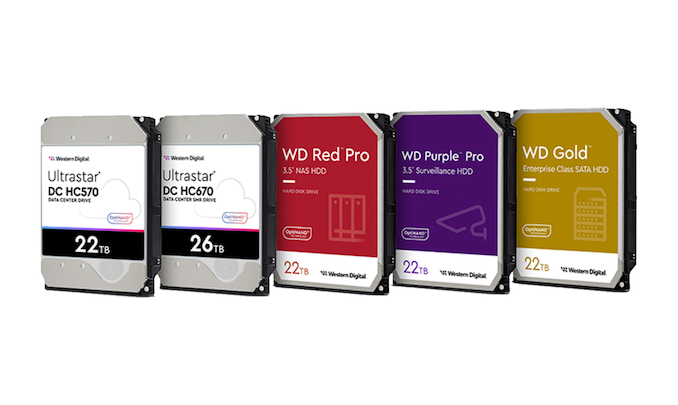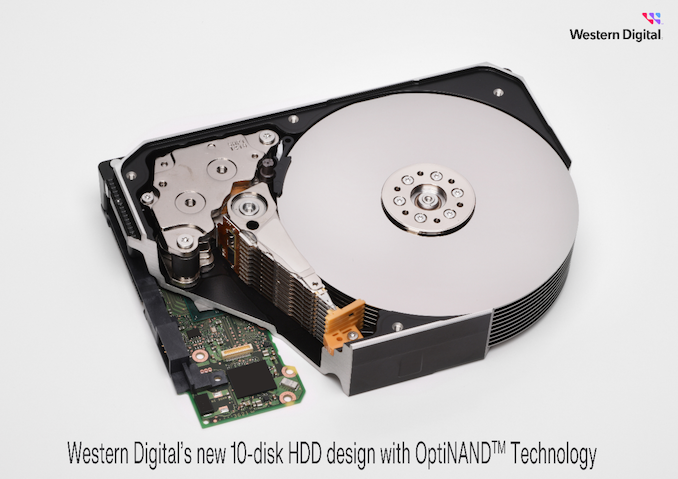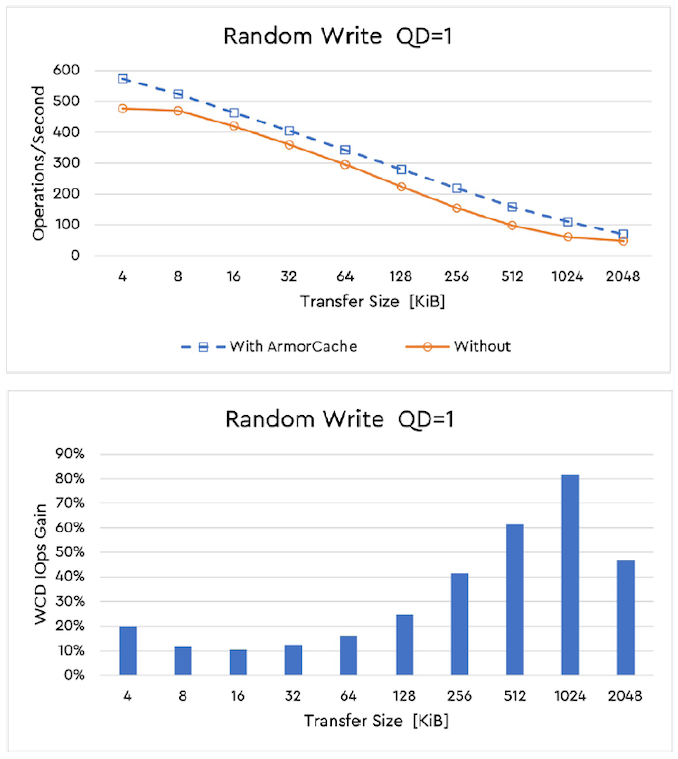Western Digital Announces 22TB CMR and 26TB SMR HDDs: 10 Platters plus ePMR
by Ganesh T S on May 9, 2022 12:01 PM EST- Posted in
- Storage
- HDDs
- Western Digital
- SMR
- Ultrastar
- WD Red Pro
- WD Purple
- WD Gold
- CMR
- ePMR

Western Digital is announcing the sampling of its new 22TB CMR and 26TB SMR hard drives today at its What's Next Western Digital Event. As usual, the hyperscale cloud customers will get first dibs on these drives. The key takeaway from today's presentation is that Western Digital doesn't yet feel the need to bring heat-assisted magnetic recording (HAMR) into the picture. In fact, WD is doubling down on energy-assisted PMR (ePMR) technology and OptiNAND (introduced first in the 20TB CMR drives). WD is also continuing to use the triple-stage actuator that it started shipping in the first half of 2020 in the new drives. It goes without saying that the new high-capacity drives are helium-filled (HelioSeal technology). The main change common to both drives is the shift to a 10-stack design.
The SMR drives are getting an added capacity boost, thanks to WD's new UltraSMR technology. This involves adoption of a new advanced error correction algorithm to go along with encoding of larger blocks. This allows improvement in the tracks-per-inch (TPI) metric, resulting in 2.6TB per platter. The new Ultrastar DC HC670 uses ten platters to provide 26TB of host-managed SMR storage for cloud service providers.
ArmorCache Technology
As part of the announcements, WD also provided additional details on the caching feature enabled by OptiNAND - ArmorCache. Last year's announcement was quite light in terms of actual performance numbers, but the 20TB OptiNAND drives have been out in the market for a few quarters now.
The UFS-based iNAND package helps the OptiNAND-based HDDs deliver upwards of 80% improvement in IOPS for low-queue depth large-sized random writes (10% - 20% improvement for small-sized writes) in use-cases where the write cache is disabled. Since non-OptiNAND HDDs can only cache whatever can be flushed out to the serial flash during emergency power-off situations, the larger cache size afforded by the iNAND device relaxes this limitation considerably. As discussed in the OptiNAND announcement coverage last year, use-cases with write caching enabled benefit from the EPO data protection afforded by the iNAND device. Enabling write caching often requires hosts to send out cache flush commands to the HDDs. These commands require the HDD to stop accepting new commands until the completion of the flush, resulting in loss of performance. The ArmorCache makes these flush commands unnecessary, allowing the drive to be used with full performance with no risk of data loss due to EPO.
Concluding Remarks
The 22TB Ultrastar DC HC570 and 26TB Ultrastar DC HC670 are currently sampling to hyperscalers. Volume shipment of the CMR drive to the channel is set for the next quarter. The Ultrastar HC HC670 is a host-managed SMR drive, and will hence ship only to select customers around the same timeframe. Western Digital will be delivering variants of the CMR drive across its HDD portfolio - 22TB WD Purple Pro for surveillance NVRs, WD Red Pro for NAS systems, and WD Gold for SMB and enterprise customers in summer.
The updated capacity points - in particular, the jump in the SMR drive capacity - delivers clear TCO benefits to WD's cloud customers. Crucially, WD believes it has enough trust in its ePMR setup to deliver 30TB+ HDDs without having to go the HAMR route. From a technology perspective, this will make the upcoming roadmap / product announcements from Seagate (HAMR deployment for publicly-available drives) and Toshiba (need for any technology beyond FC-MAMR) interesting to watch.












24 Comments
View All Comments
meacupla - Monday, May 9, 2022 - link
Has WD CMR technology been substantially improved or something? How does the CMR drive manage 2.2TB/platter, when SMR only does 2.6TB/platter?If CMR can be packed this dense, there's almost no need for SMR.
DrReD - Monday, May 9, 2022 - link
SMR has about a 20% advantage over CMR, and it's just because it leaves less space between tracks. So 2.6TB/platter SMR vs. 2.2TB/Platter CMR is exactly what you'd expect. :)WaltC - Monday, May 9, 2022 - link
Yes, the whole story of hard drive technology has been one of packing more data onto a platter.Arbie - Monday, May 9, 2022 - link
Well that's just amazing to learn. Thanks!name99 - Wednesday, May 11, 2022 - link
SMR can go higher; it's just a question of how the timing works out.If you think about it, what determines how many bits you can pack is the granularity of the underlying magnetic medium, the minimum grain sizes that can magnetize in one direction or another. Now these grains
- are random in size/shape/orientation
- are spread over the platter in a 2D fashion, not along 1D tracks.
This means, as you start approaching serious density
- extremely aggressive signal processing (so that wherever the grains don't line up correctly and bits are not stored, the missing bits can be made up from correction bits stored elsewhere.
But we have hit the limit of signal processing. So where do we go?
(a) we can go to patterned media, where you replace the random grains of current platters with "magnetic dots" laid down in a perfect pattern on a platter. Obviously that sounds great (and has great potential). Just as obviously, that does not sound cheap... So everyone's delaying it for as long as possible.
(b) the most obvious signal processing described above is one-dimensional -- you take the analog signal read by the head as it moves along a track and extract info from it. But in principle you could engage in 2D signal processing, using not just the signal along a linear track, but the full 2D signal over some fairly wide range (width of at least a few grains).
SMR is a very limited step in this direction, kinda 1.5D signal processing, using the signal along a track with some information about what's happening on the sides, but not yet fully treating the problem as one of 2D signal processing.
Going full 2D will buy a nice additional boost in capacity beyond SMR -- but probably at the cost of even slower writes...
So it's essentially more economics than tech at this point:
- do we go down the expensive (but high-performing) patterned media path OR
- do we go down the 2D signal processing path for a few years, and hope that integrated flash can hide most of the performance loss?
My (mostly uninformed!) guess is that energy assisted writes will help with a more 2D style solution, and that that, with flash, will be the more compelling path over the next ten years, until it absolutely can't be pushed any further.
If this stuff interests you, about the most approachable paper on 2D recording is:
The Feasibility of Magnetic Recording at 10 Terabits Per Square Inch on Conventional Media
https://sci-hub.hkvisa.net/10.1109/tmag.2008.20106...
(Conventional media means exactly the random granular media today, as opposed to patterned media.)
Kamen Rider Blade - Wednesday, May 11, 2022 - link
The sooner we get to Patterned Media with Hexagonally arranged magnetic grains, the better we'll be.Samus - Tuesday, August 30, 2022 - link
I wanted to mention the same thing. WD said something awhile back they could get substantial gains in capacity with SMR, but they have to draw a line somewhere balancing performance, reliability, and capacity. This is why WD and Seagate have varying capacities of SMR drives using the same platter count (and for that matter, the same Showa platters) simply due to how Seagate appears more aggressive than WD at packing data, possibly due to superior error correction or something. But my experience is Seagate SMR drives are slower than the equivalent WD SMR drive.The Von Matrices - Monday, May 9, 2022 - link
More platters = same max transfer rate but even more time to write the entire disk. It's ridiculous rebuilding a RAID with modern high capacity magnetic disks.f00f - Monday, May 9, 2022 - link
This is why more serious array vendors implement non-traditional RAID protection schemes, i.e. distributed RAID where all drives participate in rebuild process for both reads and writes (spare capacity is distributed).The Von Matrices - Monday, May 9, 2022 - link
How would that make a rebuild of an empty drive faster, which involves rewriting the entire disk? Unless you're saying that it excludes sectors that are marked as empty in the filesystem.